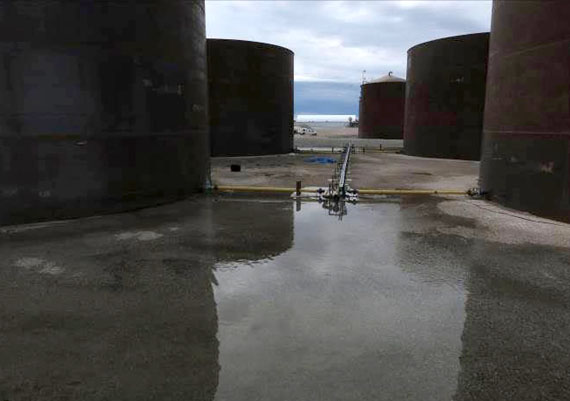AAND: Nunavut ghost mine now deemed “closed or abandoned”
Jericho fiasco continues as AAND once again warns owners

Glory days. Peter Gillen, then the CEO of Tahera Diamond Corp., with Prime Minister Stephen Harper and ex-AAND minister Jim Prentice at the highly-publicized opening of the Jericho diamond mine in the summer of 2006. From that point, the mine’s fortunes headed straight downhill. Tahera went into bankruptcy protection in 2008. Shear Diamonds, which bought the insolvent property in 2010, produced diamonds at the site for only four months in 2012 before disappearing into a financial black hole. The company’s remaining officials say they have no cash to pay for its regulatory obligations and AAND now deems the site to be “closed or abandoned.” (FILE PHOTO)

The Jericho mine’s tank farm, in a photo taken during a June 2013 site visit conducted by the NIRB and AAND. (SOURCE: NIRB SITE INSPECTION REPORT)
The mothballed Jericho diamond mine is now deemed “closed or abandoned, temporarily or permanently,” the department of Aboriginal Affairs and Northern Development declared Jan. 22 in a letter to the mine site’s legal owners, Shear Diamonds (Nunavut) Corp.
Though the moribund Jericho mine has languished in financial limbo since September 2012, this decision — under the Nunavut Waters and Nunavut Surface Rights Act — gives AAND the authority to do whatever may be required to protect people, property and the environment, the department said.
“Since leaving the site in September 2012, Shear has failed to undertake any work to remedy deficiencies, mitigate risks, or otherwise maintain the site and assets in any way, creating potential adverse effects to persons, property and the environment,” the letter said.
But at the same time, Shear is still responsible for complying with obligations set out in its project certificate, water licence, land use permits, and land leases with the Crown.
The letter, signed by Ian Gray, the AAND regional director general for Nunavut, was sent to the company’s two remaining representatives.
One of them is Manuel Rappaport of Belgium, Shear’s sole director and a financial and operational consultant for Shear’s biggest creditor: Taché Company N.V. of Antwerp, Belgium, a firm that processes and markets diamonds globally.
The other is Thomas Pladsen, a Toronto mining executive who serves as “chief restructuring officer” through an Ontario firm called 2208932 Ontario Inc.
In December 2011, Taché struck a financing deal with Shear, which in August 2010 had acquired Jericho from the insolvent company that opened the mine in 2006, Tahera Diamond Corp.
Under that arrangement, Taché gave Shear a $2 million loan, repayable over 12 months, and a $3 million line of credit.
In return, Shear agreed to deliver rough and polished diamonds to Taché from the site’s existing stockpiles, which the previous owner had left behind.
The processing system Tahera used didn’t work well. Many valuable diamonds were never extracted from tonnes of ore that Tahera had dug from Jericho’s open pit between 2006 and 2008.
In April 2012, using cash borrowed from Taché, Shear went to work on those stockpiles and started churning out diamonds.
On June 15, 2012, they began processing round the clock, going though 80 tonnes of rock a day and claiming a recovery rate of 10.9 carats per tonne.
As late as Aug. 23, 2012, Shear reported they had delivered their third parcel of diamonds to Taché, amounting to more than 22,289 carats. They also announced that Manuel Rappaport of Taché had joined their board of directors.
But at the same time, they said their processing plant would close for three weeks to accommodate repairs — and that they would deliver a fourth parcel of diamonds to Taché in mid-September.
But that never happened. On Sept. 4 — only 12 days later — Shear said the previously announced repairs had been completed ahead of time — but they suspended the processing of diamonds anyway.
In its Sept. 4, 2012 announcement, the company said diamond prices had fallen from $232 per carat to $218 per carat in one year and they couldn’t afford to continue.
“While we are gratified that we achieved our 2012 goals, we are subject to many factors that are outside our control, such as current low diamond prices. Prices have dropped significantly just as we were hitting our stride,” Julie Lassonde, then Shear’s president and chief executive officer, said in the release.
Work at Jericho ground to a halt. Shear and Taché agreed to stop shipments of diamonds and all workers were flown off site.
In October 2012, Shear gave a “temporary closure plan” to the Nunavut Impact Review Board and put the mine into mothballs.
That turned out to be the last official communication that anyone from Shear appears to have made with authorities until mid-2013.
Most of the company’s officers departed by early 2012 and all of the company’s directors, with the exception of Rappaport, quit the company’s board.
The departing officers and directors included CEO Julie Lassonde, chief financial officer Richard Belfer, director Pamela Strand, operations vice president Chris Morton and Stephanie Autut, a former executive director of the Nunavut Impact Review Board who had been hired in 2011 as vice president of environment and community affairs.
Shear’s website went dark and the company vanished from public view.
At first, AAND and other regulators appeared to be caught off guard. But in April 2013, AAND put Jericho under the federal government’s contaminated sites program.
And in June 2013, employees of NIRB and AAND flew to Jericho to do a one-day site visit and inspection, and returned in August 2013.
A subsequent inspection report found “deterioration of the site’s facilities.”
And AAND, in its most recent letter to Rappaport and Pladsen now says:
• the site was not adequately closed down in September 2012, and is not in compliance with the company’s water licence;
• Shear failed to return to the site in the winter to complete the shutdown;
• Shear continues to contravene conditions of its water licence and other regulations;
• Shear still owes money for a security deposit to cover potential reclamation costs.
This past December, AAND told NIRB they hold about $6.6 million in “cash-equivalent” security $1.7 in debentures, under Crown land leases and the Jericho water licence, to cover potential future reclamation costs.
And between June and October, AAND spent about $232,000 “to manage water levels and ensure tailings management.”
But they’re still owed what appears to be about $2 million in security.
At the same time, Shear now appears to be hamstrung by debt arising from its 2011 deal with Taché, and a requirement that AAND consent to the transfer of that debt to other potential investors.
It’s not clear how much money Shear owes Taché. But in December 2013, Pladsen told the NIRB that the company has “no source of financing” and can’t raise any money from investors or find another mine operator until AAND agrees the company’s debt can be re-assigned.
“However, until consent is received, we are unable to take any steps to consider whether any remediation is possible at this time, including the rectification of any defaults with respect to the Jericho Project Certificate, including those listed in the 2013 report,” Pladsen said.





(0) Comments